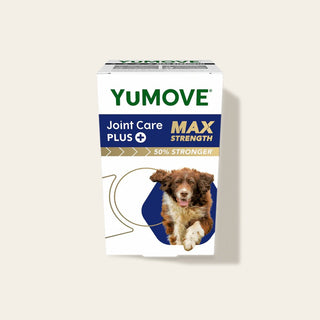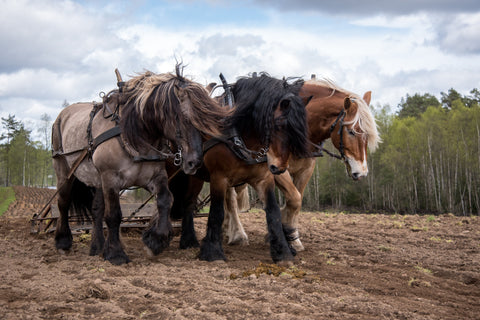

Horse joints and how they function
It can be overwhelming trying to learn everything there is to know about your horse. Especially when it comes to something more technical like the inner workings of their joints. At YuMOVE, we believe you don’t have to be an expert scientist to understand your horse’s joints!
We’ve created this at-a-glance guide to help you learn how your horse’s joints function, how to keep their joints healthy for longer, and how to recognise when there’s an issue. Read on to find out more - and don't forget, our equine supplements are designed specifically to promote joint care and reduce stiffness in horses so be sure to check them out...
What is a horse joint?
It’s quite simple, really. A joint is where two or more bones meet. Their purpose is to make your horse more flexible and to absorb any impact (concussive) shocks against your horse’s bones. In short, without joints your horse wouldn’t be able to move.
What joints do horses have?

Horses have three types of joints:
- Fibrous joints. These joints don’t allow for any movement at all (such as the joints between the bones in your horse’s skull).
- Cartilaginous joints. These joints are connected by cartilage and allow for limited movement (such as the joints in your horse’s backbone).
- Synovial joints. There are 18 different synovial joints in your horse’s body. In fact, they’re the most common type in horses and they’re the ones we’ll be focusing on in this guide.
What are synovial joints?
These joints come in all different shapes and functions, such as the ball and socket joint of the shoulder, the hinge joint of the elbow or the gliding joint of the knee. They allow for a lot of movement, and are filled with a helpful liquid that cushions and lubricates your horse’s joints – the synovial fluid.
Joint structure in horses

1. Bone
Your horse’s bones are made up of a protein called collagen. Calcium is also included in the mix to add strength. Their purpose is to support your horse’s body and help form their shape. They also protect your horse’s internal organs.
2. Cartilage
The surfaces of your horse’s bones are covered by a thin layer of cartilage (connective tissue). It has two main roles in joint health – to minimise friction on the bones and to absorb shock.
3. Joint Capsule
The joint capsule surrounds the entire joint. It’s made up of two layers:
- Fibrous layer. This is the outer layer which contains ligaments and tissues that help hold the bones together.
- Synovial layer. This is the inner layer of connective tissue that contains lots of blood vessels. It absorbs and produces synovial fluid, and is responsible for the exchange of nutrients between your horse’s blood and the joint.
4. Synovial fluid
This is found inside the hollow space in a synovial joint. It helps to lubricate and cushion the joints, absorb shock and aids with nutrient distribution.
Requirements for healthy horse joints
What do bad joints in horses look like?
Healthy joints operate efficiently and pain-free. There are many signs of joint health in horses that you probably take for granted – like mobility, flexibility, strength and general comfort. But did you know that the below signs often indicate unhealthy joints?
- Warmth
- Swelling
- Limping
- A change in your horse’s body language
- Locking of the joint
- A lower range of motion of the joint
- Stiffness
How to keep your horse’s joints healthy

Horses put a lot of strain on their joints as they walk, run, jump and work. To keep your horse active for life, we recommend following these tips to boost their joint health:
- Feed them a balanced and nutritional diet. This is key to your horse’s overall health. It’s especially important in young and growing horses to help develop strong bones and healthy joints.
- Provide your horse with regular, steady exercise. We recommend starting with small, easy exercises before increasing the intensity of your horse’s workouts. This way, your horse’s body can build stamina and their joints can slowly get used to more movement.
- Maintain a healthy weight for your horse. The heavier your horse, the higher the stress on the structures in the joints.
- Keep your horse cool after intense exercise.
- Watch out for signs of joint problems – like warmth, swelling or lameness. If joint issues are spotted at earlier stages, treatment is likely to be more effective.
- Limit their time on hard surfaces. Concussion on hard ground can cause severe damage to your horse’s joints. Check out our guide on hard ground and horses to find out more.
- Try a joint supplement to keep them active. YuMOVE Horse has been specifically designed with your equine companion in mind. It’s packed with mobility-boosting goodness to keep your horse’s joints healthy and to encourage muscle recovery. Get a rundown on our active ingredients here.
Causes of joint injuries in horses
Athletic horses tend to suffer from joint injuries more often than their less active counterparts. Young horses are also prone to injury. Often too much stress is placed on their underdeveloped joints.
The most common causes of joint injury in horses are:
- A family history of joint stiffness
- Being overweight
- Overuse of joints
- Sports/working horses
- Certain medical conditions
Sign up to a YuMOVE Horse subscription today to keep your horse healthy, happy and active for life. Plus, you’ll save 20% on each order you make! You’ll also benefit from automatic free delivery, access to special promotions and free 24/7 advice from an expert vet.



